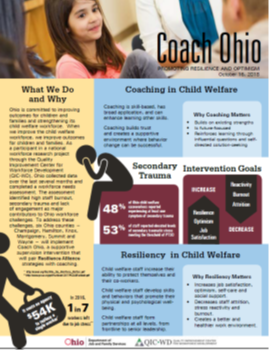Communication is Key to Success

Research on organizational communication describes a connection between poor communication, negative attitudes towards the workplace, and decreased worker satisfaction. Conversely, in an environment where communication is valued by management, staff can be encouraged to participate in practice and policy change. Too often new initiatives are announced and then fade away. Clear lines of communication, involving varying levels of staff and using a variety of methods, are key to gaining staff buy-in and keeping workers informed of initiative progress.
The Quality Improvement Center for Workforce Development (QIC-WD) is working with eight jurisdictions to develop and test promising workforce interventions. Effective communication within child welfare agencies and among leadership and staff has been instrumental to the adoption of such initiatives. The following three tips emerged as important lessons from the experience of QIC-WD sites. They are intended to help child welfare decisionmakers be transparent and gain buy-in as they work to address important workforce issues.
- Develop and deliver clear, consistent messaging about the project. Messages should include the role of staff and its impact on the workforce.
- Engage in frequent communication at all levels, about all aspects of the intervention. Communication may take on different forms (i.e., electronic, face-to-face, written).
- Balance providing information on successful strategies with an open and honest discussion about difficulties of change.
Sarah Henry, Deputy Administrator, Division of Milwaukee Child Protective Services, describes their site’s careful approach to emphasizing communication at all levels as they work to address organizational culture: "Streamlining that communication, making it earlier, making it more frequent and more meaningful, I think is a key strategy.” Transparency and elevating worker voice in decision-making have been key elements in Milwaukee’s workforce initiative.
Communication can take on different formats. The following strategies were used by QIC-WD teams in several jurisdictions to ensure effective communication about project goals, updates, and successes:
- Virginia developed short videos to support the release of their technology intervention. Some videos featured frontline workers’ reactions to the workforce innovation; others provided training or refreshers on the technology tools.
- Washington used email blasts to provide telework project information and updates to staff. They also encouraged supervisors to share information with staff and provide feedback from staff to leadership.
 Ohio created fliers that summarized issues such as staff burnout, secondary trauma, and lack of engagement as major workforce challenges. They also developed a promotional flier to describe “Coach Ohio” which pairs coaching with resilience strategies to address those challenges. The colorful flier provided data on the prevalence of secondary trauma, laid out the intervention goals, and described specific resilience strategies that workers could use.
Ohio created fliers that summarized issues such as staff burnout, secondary trauma, and lack of engagement as major workforce challenges. They also developed a promotional flier to describe “Coach Ohio” which pairs coaching with resilience strategies to address those challenges. The colorful flier provided data on the prevalence of secondary trauma, laid out the intervention goals, and described specific resilience strategies that workers could use.- Nebraska relied on regional representatives at all levels of the workforce to attend QIC-WD implementation team meetings and take key messages back to their colleagues. The implementation team meetings happened monthly throughout the project and were a tool for workers to bring concerns to the implementation team; the regional representatives also took questions from the implementation team to their coworkers to ensure feedback and awareness of the project. For major events, such as project kick-off or evaluation activities which required high rates of participation, more formal forms of written communication from agency leadership were also used.
 Louisiana created a project-specific newsletter to provide practice information to staff, communication tips for teams working remotely, and encouragement to staff such as announcing birthdays, promotions, and new staff. The newsletter also featured staff testimonials about their experience. The goal was to keep staff connected and engaged when they shifted to remote work (due to the pandemic) and could no longer have large staff meetings.
Louisiana created a project-specific newsletter to provide practice information to staff, communication tips for teams working remotely, and encouragement to staff such as announcing birthdays, promotions, and new staff. The newsletter also featured staff testimonials about their experience. The goal was to keep staff connected and engaged when they shifted to remote work (due to the pandemic) and could no longer have large staff meetings.- Milwaukee regularly incorporated information on their intervention (Availability Responsiveness Continuity or ARC) into their regular agency staff meetings. Lilia Figueroa, Site Implementation Manager, stated that, “We give ARC its own time slot of being a stand-alone item on the agenda every single time… they want to be intentional with the information that's being communicated..."
Although the QIC-WD sites used different communication techniques, all site representatives agreed that communication was a key to implementing their workforce initiative. (See this short video on the Importance of Communication When Implementing Workforce Changes to hear more from site leaders.) Communication was an important implementation tool (see the Three Keys to Implementation video) in large agencies with thousands of employees and smaller sites, like Milwaukee, where everyone worked in one building. Ensuring effective communication requires consistent messages, sent multiple times, in a variety of formats. Communication strategies were used to gain buy-in, inform staff of trainings and evaluation activities, and to generally increase awareness of and keep people engaged in the initiative.